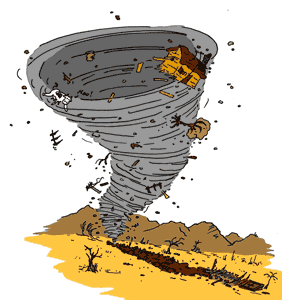The flashpoint or inciting event of a story is its first turning point and has the function of bringing chaos where there was order.

It is the point of no return and the trigger that gives rise to conflict and action. All in all, it is the event that provides the writer with a story to tell. Here are some flashpoint examples:
The Wizard of Oz: The tornado that transports Dorothy from Kansas to Oz.
Casablanca: Ugarte decides to hand Rick the envelope with the letters of transit.
Star Wars: Darth Vader attacks Princess Leia’s spaceship.
In the last example (Star Wars), the flashpoint is not visible to the spectator as it occurs before the first scene of the film. This also happens in many detective stories such as those of Sherlock Holmes. The critical moment, either a robbery or a murder, is usually prior to the beginning of the story.
When should it happen?
As you have seen in the examples, the flashpoint lacks a fixed position. In some cases, it can occur before the story begins while in other cases, it happens after the introduction because the author decides to present the characters and their universe first. Which of these options is the best? It depends. Sometimes, it will be more interesting to get to the point so your readers (or spectators) get hooked to the story from the beginning.
Other times, it will be more advisable that you first focus on the context surrounding the story so those reading it identify themselves with the protagonist and better understand the importance of the flashpoint. In any case, this should take place before the end of the first quarter of the story, or you’ll have an introduction that’s too long. Be careful to avoid that because it might bore your readers.
How do you know you have chosen a good flashpoint?
This may seem like the million dollar question, but it isn’t. There are a number of aspects you can consider in order to determine whether or not you have chosen a good flashpoint.
Change – It must introduce some variation in the plot and permanently alter the life of the characters in some way with no turning back.
Conflict – It must bring about some type of conflict between the characters.
Action – Or better said, reaction. The crucial moment must have consequences; it must provoke action and make things happen.
Suspense – If you take into account the three aspects mentioned above, your flashpoint will create suspense and intrigue. In addition, it will also encourage readers to ask themselves how they think the story will continue, and that will keep them reading.
Related Posts:
How to Write the First Paragraphs of Your Novel
The Four Key Story Elements
How to Introduce Conflict in a Story
 This site uses cookies. By continuing to browse the site, you are agreeing to
This site uses cookies. By continuing to browse the site, you are agreeing to 



There are no comments in this entry. Go ahead and leave yours!